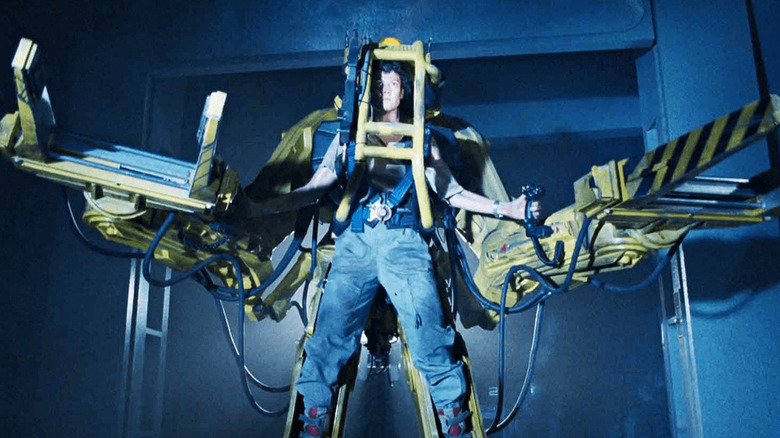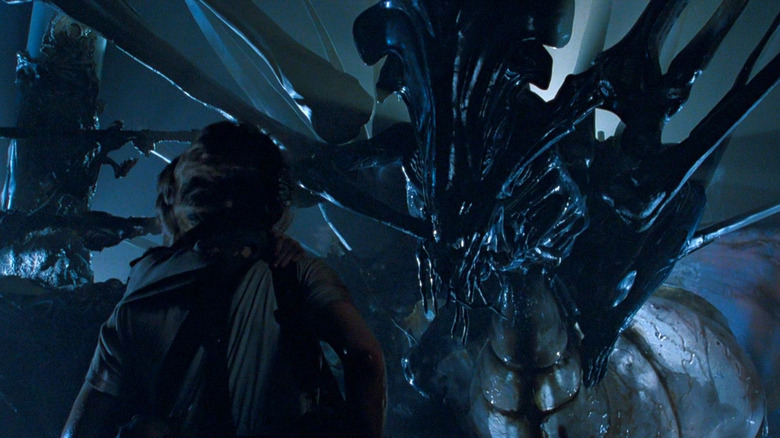James Cameron Redesigned Aliens' Power Loader After Seeing Empire Strikes Back
On the subject of the rare sequels that equal or excel their predecessors, "Aliens" is surely one of the most popular nominations. James Cameron's 1986 sci-fi action extravaganza comes seven years after Ridley Scott's terrifying slasher-in-space "Alien," though Cameron was tapped to write the sequel years earlier. He already had "The Terminator" and a script for "Rambo: First Blood Part II" under his belt, and would carry the intensity of both into his "Alien" franchise entry.
This time, Ellen Ripley (Sigourney Weaver), the sole human survivor of the Nostromo, is back to aid locked-and-loaded Colonial Marines in search of a lost terraformer colony on exomoon LV-426; there, the movie's title comes into play. Nearly two hours of movie (or longer, depending on the cut) goes by as the humans battle the H.R. Giger and Stan Winston-created xenomorphs and facehuggers, culminating in what /Film's Lee Adams calls "one of cinema's greatest climactic showdowns in one of the best sequels" ever: Ripley, operating a power loader, exchanges blows with the formidable alien queen. After the rescuing young colony survivor Newt from an alien cocoon, and after setting the queen's nest (and the eggs therein) aflame, it's a matriarch melee to determine the Alpha Mom.
The battle in "Aliens" is a technical triumph of CGI-free creature effects. Weaver would smack around a 14-foot behemoth operated by over 14 puppeteers, with the further help of hydraulics and a crane, and the indispensable lead actor would further conjure an authentic performance by avoiding the queen until the puppet operators had the creature "in character." A dig into the interview archives of sci-fi magazine Omni and collected in the book "James Cameron: Interviews," the "Avatar" director divulges that the iconic power loader Ripley maneuvers once had a more arachnid-like design, before a space opera forced him back to the drawing board.
Get away from her, you b****
In the book, Cameron tells the tale of one of his earliest films, orchestrated among a crew of his friends and financed by "the rich, Mormon dentists out in Orange County." Set aboard a star-sailing colony vessel and the planet the ship is bound for, this sci-fi story had several out-of-this-world innovations, including a device Cameron dubbed "the Spider." The device, like the power loader, used "tele-presence-type amplification." As Cameron describes in the book:
"You put your feet in things, you grabbed onto these controls, and however you moved and walked, it duplicated your actions.
When we filmed it, we filmed an actress manipulating these controls, and then we rear projected it inside an animated, hydraulically activated model. We animated it to her; it worked really well. It was an amazing piece of work for a bunch of dumbs**** that didn't know what they were doing. A year and a half later, 'The Empire Strikes Back' came out with these big walking machines in it. I felt vaguely ripped off, or scooped would be more accurate. So I changed 'the Spider' to more of an upright, forklift exoskeleton concept."
The result would herald a new kind of action heroine and comes alongside one of the film's most-quoted lines.
For her latest role, catch Weaver turning back the clock to play a teenager in another sequel, a follow-up to one of the biggest blockbusters ever: she's returning to the mo-cap world of the Na'vi as young adolescent Kiri in James Cameron's "Avatar: The Way of Water," opening in theaters on December 16, 2022.

